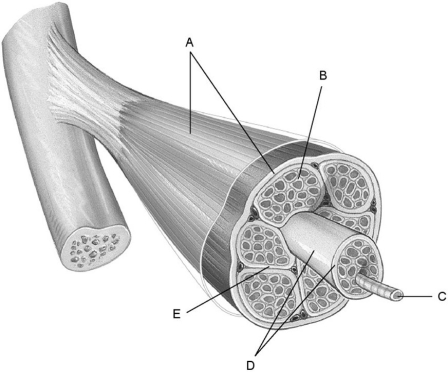A) elastic (titin) filaments
B) potassium (K+) leak channels
C) acetylcholine receptors in the motor end plate
D) thick (myosin) filaments
Correct Answer

verified
Correct Answer
verified
Multiple Choice
When a sarcomere contracts and thin filaments move over thick filaments you would expect to see ________.
A) the H zone to appear wider
B) the I bands to appear smaller
C) the I bands to appear wider
D) the A band to appear darker
Correct Answer

verified
Correct Answer
verified
Multiple Choice
A potential benefit of recruiting slow oxidative fibers for contraction before recruiting fast oxidative and fast glycolytic fibers might be ________.
A) because they are slower to respond, slow oxidative fibers must be stimulated first in order to contract simultaneously with the faster fibers
B) there is little to no benefit from recruiting slow oxidative fibers first and therefore it is in fact fast glycolytic fibers that will be recruited first
C) recruiting slow oxidative fibers early helps to tire them out first so that they won't interfere with the more powerful contractions of fast glycolytic fibers
D) this will help to allow for fine control with delicate contractile force with a small stimulus
Correct Answer

verified
Correct Answer
verified
Multiple Choice
What structure in skeletal muscle cells functions in calcium storage?
A) intermediate filament network
B) sarcoplasmic reticulum
C) mitochondria
D) myofibrillar network
Correct Answer

verified
Correct Answer
verified
Multiple Choice
What is the functional unit of a skeletal muscle called?
A) a myofibril
B) the sarcoplasmic reticulum
C) a sarcomere
D) a myofilament
Correct Answer

verified
Correct Answer
verified
Multiple Choice
 Figure 9.1
Using Figure 9.1, match the following:
-Individual muscle fiber.
Figure 9.1
Using Figure 9.1, match the following:
-Individual muscle fiber.
A) A
B) E
C) D
D) C
E) B
Correct Answer

verified
Correct Answer
verified
Multiple Choice
Which of the following statements is most accurate?
A) T tubules may be sliding during isotonic contraction.
B) Myofilaments slide during isometric contractions.
C) Muscle tension remains relatively constant during isotonic contraction.
D) The I band lengthens during isotonic contraction.
Correct Answer

verified
Correct Answer
verified
Multiple Choice
Match the following: -The situation in which contractions become stronger due to stimulation before complete relaxation occurs.
A) Tetanus
B) Maximal stimulus
C) Wave summation
D) Muscle tone
E) Multiple motor unit summation
Correct Answer

verified
Correct Answer
verified
True/False
Although there are no sarcomeres,smooth muscle still possesses thick and thin filaments.
Correct Answer

verified
Correct Answer
verified
Showing 121 - 129 of 129
Related Exams